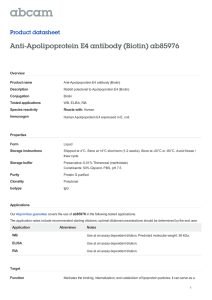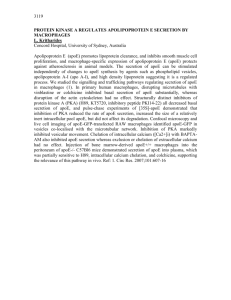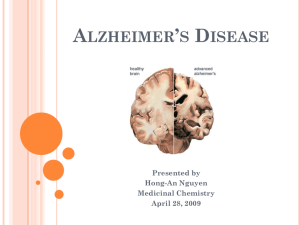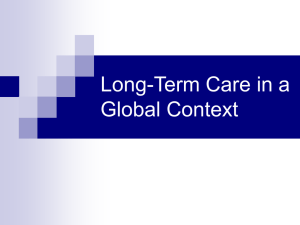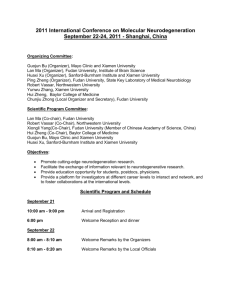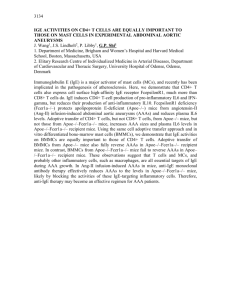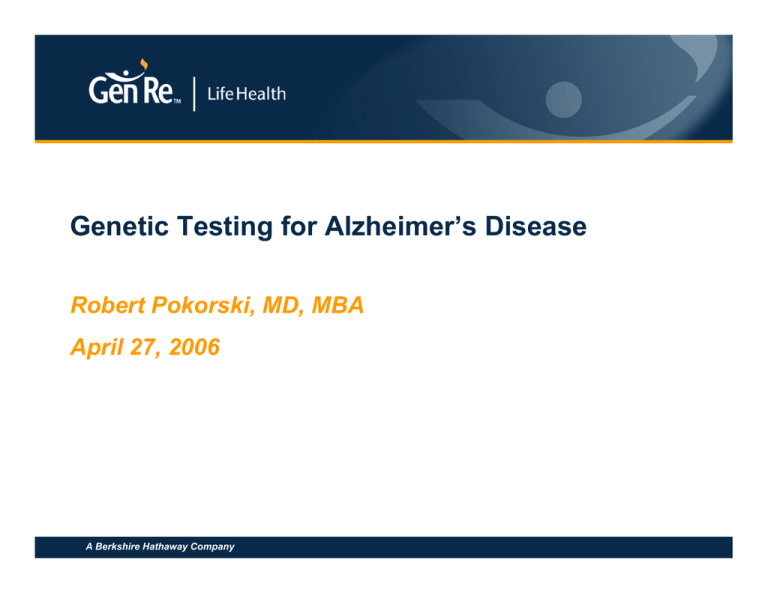
Genetic Testing for Alzheimer’s Disease
Robert Pokorski, MD, MBA
April 27, 2006
A Berkshire Hathaway Company
Anti-trust statement & Copyright
Anti-trust statement
General Re Life Corporation adheres to antitrust laws. The information
provided in this lecture is intended to advance the knowledge and
improve the risk assessment skills of the participants. Under no
circumstances shall this lecture be used as a forum for the pricing of
specific products or for determining how they are marketed.
Copyright
The material contained in this presentation has been prepared solely for
informational purposes by General Re Life Corporation (“GRL"). The
material is based on sources believed to be reliable and/or from
proprietary data developed by GRL, but we do not represent as to its
accuracy or its completeness. This document and its contents are
proprietary to GRL. Neither this document nor its contents may be copied
or reproduced in any manner without the express written consent of GRL.
Copyright © 2006 General Re Life Corporation. All rights reserved.
2 of 38
Early Testing for Alzheimer’s Disease
• Genetics / APOE
• REVEAL Study
• Underwriting
• Managing the risk
3 of 38
Introduction
• Alois Alzheimer reported Alzheimer’s disease (AD) in 50year-old woman (1907)
• AD causes 2/3 of dementia
• 7.1% of all U.S. deaths due to AD in 1995
– Roughly same as cerebrovascular disease (3rd cause of death)
• 2 types
– Early-onset (familial)- 2% of AD
– Late-onset (nonfamilial, sporadic, APOE-related)- 98% of AD
4 of 38
Early-onset (familial)
• Autosomal dominant → ½ of children affected
• Age at onset
– 40s, 50s, sometimes even 20s
– Never after 65
• Caused by 3 genes that disrupt amyloid brain metabolism
– APP (amyloid precursor protein)
– Presenilin 1
– Presenilin 2
5 of 38
Late-onset (nonfamilial, sporadic, APOE-related)
• The gene APOE produces the lipoprotein apolipoprotein E
(APOE)
• APOE primary component of very low density lipoproteins
(VLDL) which carry cholesterol from blood to liver
• APOE important for cholesterol transport within brain
6 of 38
Apolipoprotein E (APOE) genotypes
• Genotype- Three alleles
(versions) of APOE gene
– e2- Lower AD risk
– e3- Average AD risk
– e4- Higher AD risk
• APOE genotyping not
routine, but many patients
request it ($299)
Frequency of APOE genotypes in U.S. and
relative risk of AD for controls vs. AD cases*
A
B
C
D
Controls
AD
Relative risk
Genotype
†
(%)
(%)
(C / B)
e2/e2
0.8
0.2
0.3
e2/e3
12.7
4.8
0.4
e2/e4
2.6
2.6
1.0
e3/e3
60.9
36.4
0.6
e3/e4
21.3
41.4
1.9
e4/e4
1.8
14.8
8.2
No e4
74.4
41.4
0.6
1 or 2 e4
25.7
58.8
2.2
* Ashford JW. J Mol Neurosc 2005;23:157-65.
†
e.g., 1.8% of control group e4/e4, but 14.8%
of AD cases e4/e4 (14.8/1.8 = 8.2).
7 of 38
APOE affects age at onset
• Age at which 50% have AD
– e4/e4- Age 68
– e3e/4- Age 76
– e3/e3- Age 84
• By age 80, percent with AD
– e4/e4- 91%
– e3/e4- 48%
– No e4- 20%
• e2/e2 overly represented among centenarians
• No e4/4 has reached 90 without AD
8 of 38
Causes of Alzheimer’s disease
Genetic (definite)
Nongenetic (possible)
APP
Toxins
Presenilin 1
Viruses
Presenilin 2
Down’s
syndrome
Other
genes
Most common
pathway:
Environment +
genes (APOE,
others) + aging
Prions
Low
education
Head trauma
9 of 38
Pathophysiology
Gene mutation → Increased brain production of
amyloid ß peptide and/or defective amyloid ß peptide
Amyloid ß peptide accumulates as plaques that
disrupt neurotransmission between neurons
Neurons malfunction / die
Dementia
10 of 38
Life expectancy after initial clinical
diagnosis decreases with older age
Life expectancy after initial clinical diagnosis of Alzheimer’s disease in 521 patients
†
compared with the U.S. population, by quartile and age at diagnosis*
Age 70
Age 80
Age 90
75% 50% 25% 75% 50% 25% 75% 50% 25%
Female
U.S population 21.3 15.7
9.5
13.0
8.6
4.6
6.8
3.9
1.8
Alzheimer’s
12.3
8.0
5.9
8.7
5.3
3.2
5.2
2.1
1.6
Male
U.S population 18.0 12.4
6.7
10.8
6.7
3.3
5.8
3.2
1.5
Alzheimer’s
5.1
4.4
3.1
6.8
3.6
2.2
4.9
2.7
0.9
* Larson EB. Ann Intern Med 2004;140:501-9.
†
Life expectancy quartile at initial clinical diagnosis can be estimated by factors such
as cognitive status (e.g., Mini-Mental State Exam), comorbidity (e.g., cardiovascular
disease, cancer, frailty), and instrumental activities of daily living.
11 of 38
Treatment not good, will improve
• May slow progression for 6-12
months (some better than others)
– Razadyne® (galantamine)Anticholinergic
– Exelon® (rivastigmine)Anticholinergic
– Aricept® (donepezil)Anticholinergic
– Cognex® (tacrine)Anticholinergic
• Ineffective
– Vitamin E (NEJM
2005;352:2379-88)
– Statins (Arch Neurol
2005:62:1047-51)
• Experimental (lab mice)
– Amyloid ß peptide vaccine for
prevention / treatment of
existing AD
– Namenda® (memantine)Glutamate regulator
– Evista® (raloxifene)- Selective
estrogen receptor blocker
12 of 38
Early Testing for Alzheimer’s Disease
• Genetics / APOE
• REVEAL study
• Underwriting
• Managing the risk
13 of 38
REVEAL first study to show that genetic
information changes how people buy insurance
Genetic Testing For Alzheimer’s Disease
And Its Impact On Insurance Purchasing
Behavior
Widespread genetic testing for Alzheimer’s
susceptibility could present dilemmas for long-term
care insurance
by Cathleen D. Zick, Charles J. Mathews, J. Scott Roberts, Robert CookDeegan, Robert J. Pokorski, and Robert C. Green
Health Affairs 2005 (March);24:483-90
14 of 38
REVEAL (Risk Evaluation and Education
for Alzheimer’s Disease) Study
• Randomized controlled trial to evaluate impact of genetic
education (learning APOE genotype) on 148 adult
children of AD patients
• Control group (46 subjects)- Told of AD risk based on age
/ gender / family history
• Intervention group (102 subjects)- Told of AD risk based
on age / gender / family history / APOE genotype
15 of 38
Subjects with family history of AD more
likely to have already purchased LTC
• Percentage with insurance at beginning of study
– Health- 97%
– Life- 78%
– Disability- 40%
– LTC- 20%
• In U.S., 7% of aged 65+ have LTC insurance, compared to 20%
baseline in REVEAL
• Even before APOE known, subjects with family history of AD
were 3 times more likely to have already purchased LTC
– Other possible reasons for greater baseline LTC coverage were higher
income / education / socioeconomic status
16 of 38
Results
Percentage of subjects who changed / thought about changing insurance coverage in year after learning of AD risk based on age, sex, family history, and APOE
Percent reporting a change
Percent thinking about a change
Type of
No APOE
E4
E4
No APOE
E4
E4
Insurance disclosure Negative Positive disclosure Negative Positive
(n = 46)
(n = 54)
(n = 48)
(n = 48)
(n = 46)
(n = 54)
6.5
5.6
12.5
23.9
13.0
25.0
Health
6.5
7.4
2.1
4.4
5.6
16.7
Life
4.4
3.7
4.2
8.7
7.4
18.8
Disability
4.4
1.9
16.7
32.6
22.2
45.8
LTC
Pokorski RJ, et al. Health Affairs 2005 (March);24:483-90.
In all cases, change meant “increase” coverage.
Life
e4 positive more likely to think of changing coverage
LTC
e4 positive much more likely to change / think of
changing coverage, e4 negative less likely to change
17 of 38
AD “perfect storm” for LTC antiselection
• “Perfect storm”
– High likelihood of needing care
– APOE gives significant (but incomplete) predictive information
– LTC private market in U.S.
• Overall, e4 positive subjects 5.8 times more likely to
increase LTC coverage
• Authors suggest LTC purchase might increase further
with older age, i.e., no perceived need to buy LTC at age
52 (average age of study subjects)
18 of 38
Early Testing for Alzheimer’s Disease
• Genetics / APOE
• REVEAL study
• Underwriting
• Managing the risk
19 of 38
Incidence rate of AD doubles every 5 years
Age 62- 1 new case per
1000 people
Age 79- 1 new case per
100 people
Age 94- 1 new case per
10 people
Are underwriting
requirements, especially
cognitive testing, in line
with AD incidence rates?
Age 105- Incidence rate
equals mortality rate
20 of 38
Family history (FH)
• 25% of late-onset AD have close relative with AD
• Ask older applicants about FH
– “At what age was condition diagnosed (e.g., AD, heart disease,
cancer),” not “At what age did death occur from condition”
• FH important if
– Any AD under age 60
– AD in two or more elderly parents, siblings, aunts, uncles
21 of 38
Likelihood of AD varies
with age, family history, APOE
Prevalence of Alzheimer's disease, males
Cumulative prevalence (%)
30
25
Annual incidence of AD
between ages 65 and 80
27
Population: 0.3%
20
15
First degree relative: 0.8%
13
APOE e3/e4: 1.6%
10
7
5
5
2
0.4
0
0
55
60
65
70
75
80
85
Age
Cupples LA, et al. Genet
Med 2004;6:192-6.
Population
First degree relative
APOE e3/e4
22 of 38
Attending physician’s statement often not helpful
Physician usually does
not know about mild AD
Physician may not record
AD diagnosis in records
“Potential harm of early identification of dementia
relates to repercussions of the label of cognitive
impairment, including inability to obtain life or health
insurance” (J Am Geriatr Soc 2000;48:1430-34)
23 of 38
Memory loss = AD until proven otherwise
If memory loss
• Full evaluation by specialist
– Cognitive tests- Borderline low score often / usually = early AD
– MRI, blood, etc., for other impairments- Depression, brain tumor,
multi-infarct dementia, systemic illness
• Time (12 months, minimum) for physician to follow
patient, repeat tests (mild cognitive impairment → AD at
10%-15% per year)
24 of 38
Applicants with known AD
• Suicide risk- Claims within contestable period might be
“accidental death”
• Moral risk if beneficiary initiates insurance purchase
• Legal risk- Often cannot contest misrepresentation
(applicant forgot past medical history)
• Risk classification difficult because great variation in
survival data in medical literature
25 of 38
AD major concern for LTC & products
with LTC rider … even without APOE issue
• AD already most common / most costly / longest LTC claim
• Dementia definition weak
– Easy to misrepresent “Significant impairment on cognitive test”
– Easy to misrepresent “Need for continuous supervision”
• REVEAL
– People with FH of AD 3 times more likely to already have LTC
– e4 positive subjects 5.8 times more likely to increase LTC coverage
26 of 38
AD incidence will increase
• Growing emphasis on screening for prevention / early
treatment (when better treatment becomes available)
• Routine screening in future for people with early
memory loss, family history of AD, “worried well,”
healthy elderly
– www.medafile.com
– Free online memory test for early identification of AD
– Suggested frequency- Age 50-65, each year; 65+, every 3 months
27 of 38
Tests to screen for AD
Neuropsychological tests
Delayed word recall, other
1. MRI- Small hippocampus (memory)
Brain scans
Electroencephalograph (EEG)
2. PET (positron emission tomography)
scan- Slower glucose metabolism
Abnormal pattern predicts AD
Scratch and sniff test
Abnormal with AD (strawberry, lemon,
smoke, lilac, leather), online purchase
Genetic predisposition
Family history, apolipoprotein e4
Mathematical models
Combine data from above to predict AD
28 of 38
Claims scenarios when AD incidence increases
No breakthrough in treatment
What happens if
incidence of AD
increases in 2010 due
to routine screening?
What happens if AD
cured, controlled, or
prevented in 2025?
↑ number of claims, ↑ claim duration
Breakthrough in treatment
↑ number of claims, ↑ claim duration
↑ number of claims, ↓ claim duration
↓ number of claims, ↑ claim duration
↓ number of claims, ↓ claim duration
↓ ↓ ↓ in number, duration of claims
29 of 38
What insurers can do
when / before AD incidence increases
1. More cognitive tests based on age,
amount at risk, cost / benefit analysis
– e.g., age 60- $500,000+
Underwriting
– e.g., age 65- $250,000+
2. Use family history to modify risk
3. Physician’s statement often won’t
reveal existing AD
Claims
More restrictive benefit criteria
Pricing
Increase price
Product design
Reduce risk per contract provisions
30 of 38
Early Testing for Alzheimer’s Disease
• Genetics / APOE
• REVEAL study
• Underwriting
• Managing the risk
31 of 38
AD already very important cause of claim
Alzheimer's disease as a cause (%)
of LTC Claims, by issue year
50%
40%
30%
20%
15%
36%
39%
1984-1991
Dollars
1992-2001
Dollars
23%
10%
0%
1984-1991
Count
1992-2001
Count
Source: SOA LTC Intercompany Experience Study
32 of 38
Managing the risk
• Pricing
– Antiselection certain → size of impact uncertain, but likely significant
– Low market penetration compounds antiselection
Product benefits
– Higher / lower AD risks likely to choose higher / lower benefits
– Continue to offer wide choice of benefit options?
– Continue to offer unlimited lifetime benefit?
– Offer new benefits for AD prevention / treatment?
• Product wording
– Claim trigger defensible against claims for pre-symptomatic / mild
AD?
33 of 38
Managing the risk
• Marketing
– Will agents / financial planners recommend APOE testing?
– Will emphasizing AD in marketing attract more applicants with
positive family history / e4?
– Will AD tests encourage existing insureds to test for AD?
• Cancel policy if negative?
• Upgrade to “better” policy if positive?
• Claims
– Pay only on objective criteria in contract wording?
– Fear of lawsuits → pay on AD diagnosis / early dementia?
34 of 38
Managing the risk
• New underwriting questions
– Family history of AD?
– Had any test indicating higher likelihood of developing AD?
• Regulatory
– Most states allow use of genetic information for LTC, a few do not
• Public Relations
– Fair / unfair to use genetic information? Only a risk, not an
impairment? Not my fault?
– Fair that low risk subsidize high risk insureds?
– Private insurance optional → vulnerable to antiselection
– Public programs that mandate participation less vulnerable
35 of 38
Why insurance companies do dumb things*
• Denial of problem
• Tension between short- and long term goals
– e.g., need to meet quarterly sales targets greater than worry about
long term risks
* Crompton, Robert B. Why insurance companies do dumb things. Contingencies Nov/Dec
2003, p. 8-12
36 of 38
Why insurance companies do dumb things
Antiselection not
a problem
We’ve priced
for this
Don’t need more
cognitive tests
We’ll sort this out
next quarter
Underwriting
protects us
Do any of
these beliefs
apply to LTC
insurance?
We can always raise
rates if mistakes
in product design
Claims people
protect us
Market share our #1
goal (same as many
former LTC insurers)
Treatment will
decrease claims
I’ll be long
retired by then
37 of 38
Genetic Testing for Alzheimer’s Disease
Robert Pokorski, MD, MBA
A Berkshire Hathaway Company

